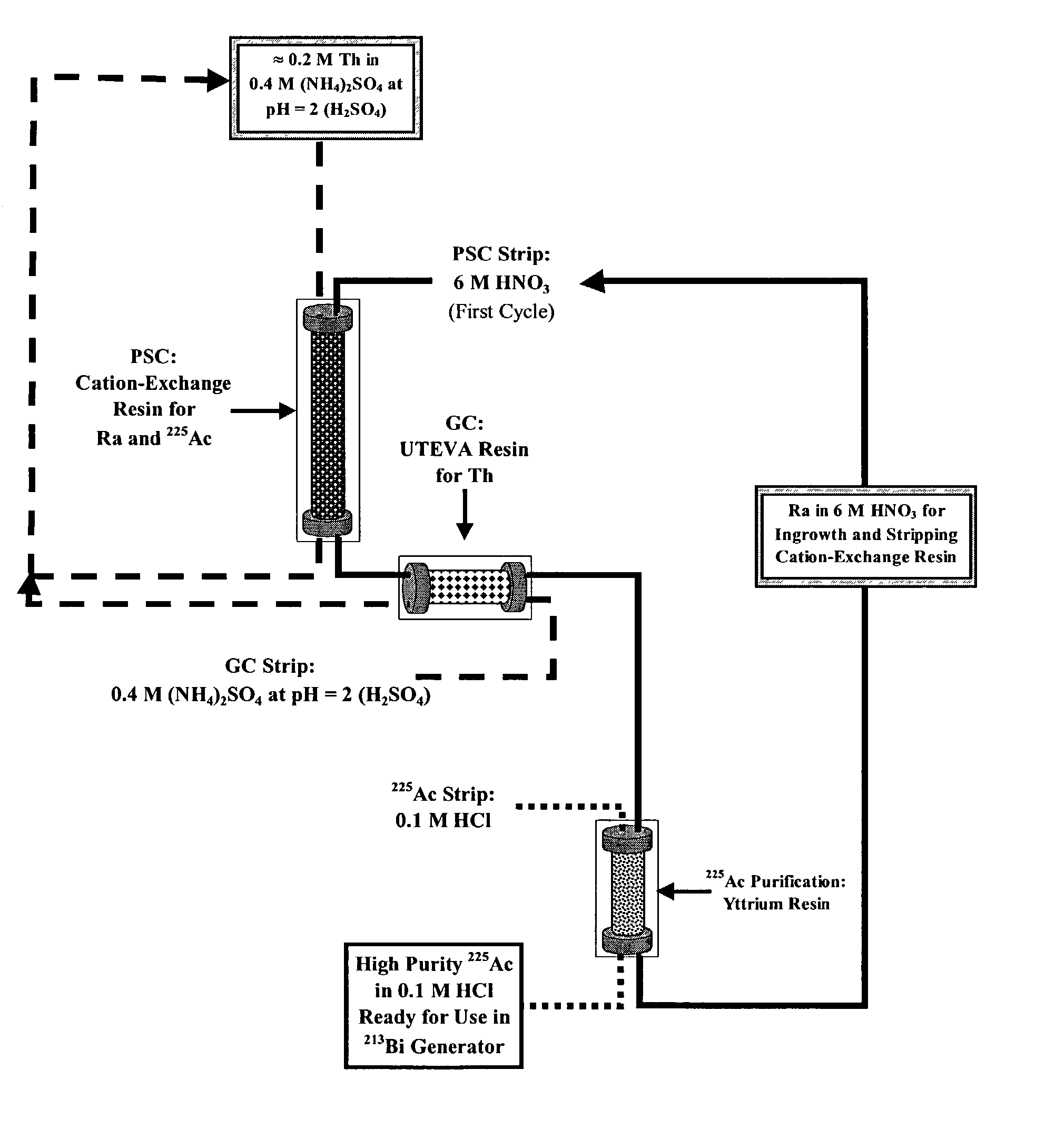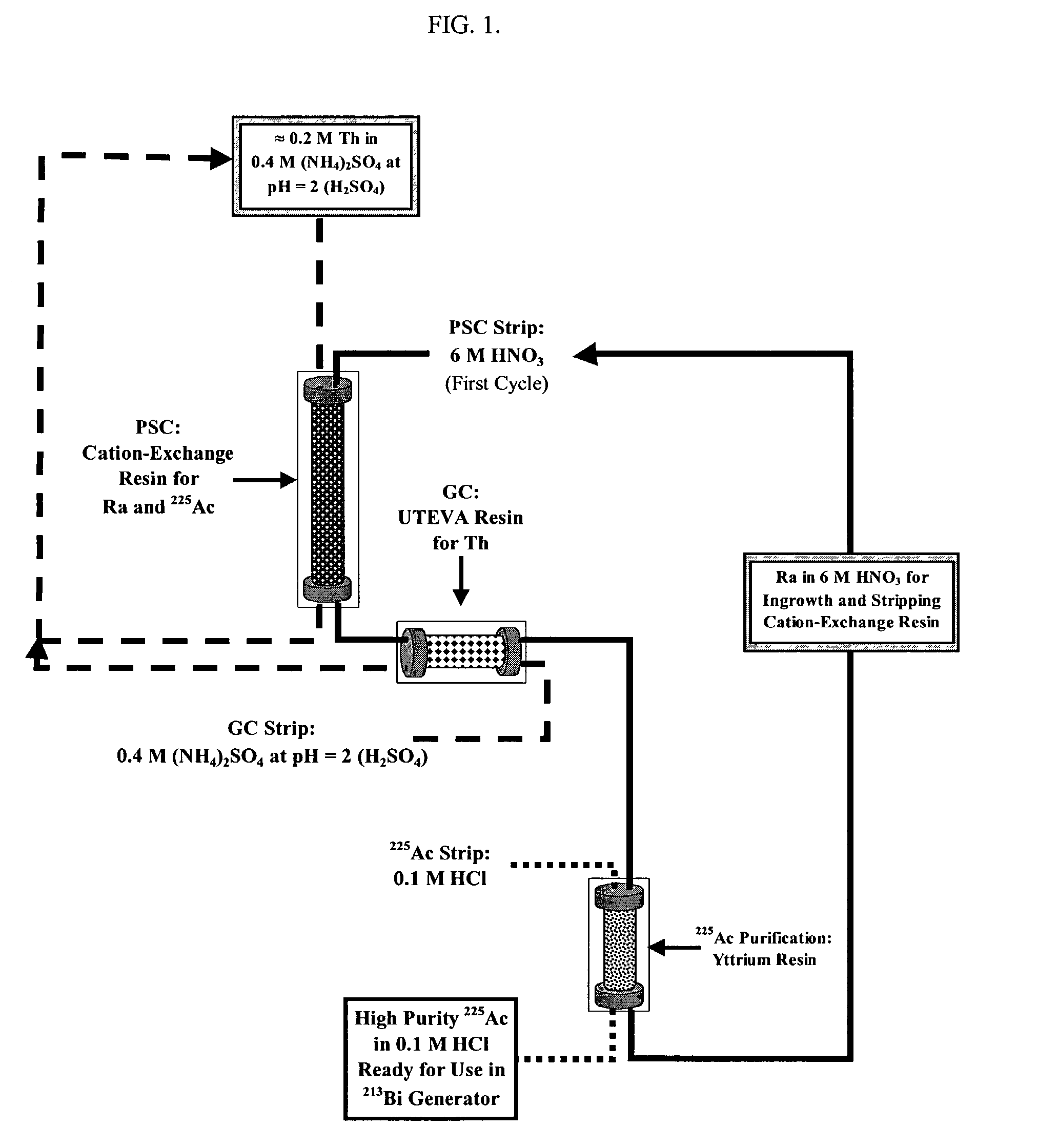Multicolumn selectivity inversion generator for production of high purity actinium for use in therapeutic nuclear medicine
- Summary
- Abstract
- Description
- Claims
- Application Information
AI Technical Summary
Benefits of technology
Problems solved by technology
Method used
Image
Examples
example 1
Preparation of Yttrium (TO-DGA) Resin
[0103]The separation medium used herein containing TO-DGA was prepared using a general procedure described previously for another separation medium [Horwitz et al., Anal. Chem. 1991, 63, 522-525]. A portion of TO-DGA (4.0 g) was dissolved in about 30 mL of CH3OH and combined with 50-100 μm Amberchrom-CG71 particles (6.0 g) in about 20 mL of CH3OH. The mixture was rotated at about 40° C. on a rotary evaporator for about 30 minutes, after which the CH3OH was vacuum distilled. After the bulk CH3OH had been distilled, the free flowing resin was rotated under vacuum at about 40° C. for another 30 minutes to remove residual CH3OH. The resulting solid is referred to as Yttrium Resin and corresponds to 40% (w / w) loading of TO-DGA on 50–100 μm Amberchrom-CG71 particles.
example 2
Extraction Studies with Yttrium Resin
[0104]The TO-DGA molecules behave as neutral extractants; that is, solute loading occurs at high acid (e.g., nitric (HNO3) or hydrochloric (HCl) acids) or salt concentrations (e.g., lithium nitrate (LiNO3) or aluminum nitrate (Al(NO3)3) and stripping is accomplished using dilute acid or salt solutions. One particularly noteworthy characteristic of the TO-DGA resin, shown below, is the high uptake of polyvalent cations from 0.1–5 molar HNO3 and the efficient stripping of these same cations using dilute (≦0.5 M) HCl. The elution behavior of several tri-, tetra-, and hexavalent cations on TO-DGA extraction chromatographic material described before are tabulated below.
[0105]
Elution Behavior of Selected Cationson TO-DGA Resin*Percent of TotalFractionBed VolumeAlYThULoad (0.5 M HNO3)2.066000Rinse (0.1 M HNO3)2.02800752.00008.42.000002.000002.00000Strip (0.1 M HCl)2.00247802.00761602.000002.000002.00000*Bed volume = 0.5 mL; Flow rate = 0.1 mL / min for lo...
example 3
Thorium From Daughters Separation Scheme
[0115]Adapting the fundamental concept of using an aqueous phase complexing agent to preclude Th(IV) uptake by the extraction medium to operate within the context of a robust process led to consideration of inorganic anions as aqueous phase complexing agents. Because macroquantities of Th(IV) are present, the NO3− salts are a logical choice due to the high solubility of Th(NO3)4 in aqueous media. Unfortunately, most NO3−-based extraction systems require polycarboxylate complexing agents [to keep Th(IV) off the extraction medium] or require extraction of Th(IV) macroconstituent. A similar analysis of Cl− and PO43− systems provided various shortcomings, including a lack of solubility of Th(IV) salts of the latter anion.
[0116]Sulfate (SO42−) ion solutions represent an interesting possibility because, at first intuition, Th(IV) is not anticipated to be soluble in such media. Thorium sulfate is, however, an aqueous-soluble salt and the solubilities...
PUM
| Property | Measurement | Unit |
|---|---|---|
| Fraction | aaaaa | aaaaa |
| Molar density | aaaaa | aaaaa |
| Molar density | aaaaa | aaaaa |
Abstract
Description
Claims
Application Information
 Login to View More
Login to View More - R&D
- Intellectual Property
- Life Sciences
- Materials
- Tech Scout
- Unparalleled Data Quality
- Higher Quality Content
- 60% Fewer Hallucinations
Browse by: Latest US Patents, China's latest patents, Technical Efficacy Thesaurus, Application Domain, Technology Topic, Popular Technical Reports.
© 2025 PatSnap. All rights reserved.Legal|Privacy policy|Modern Slavery Act Transparency Statement|Sitemap|About US| Contact US: help@patsnap.com



